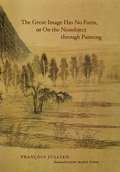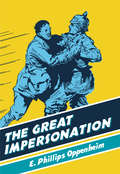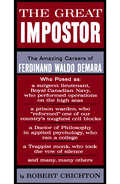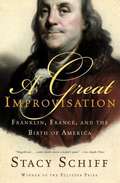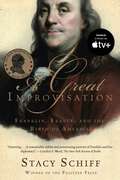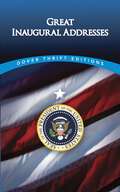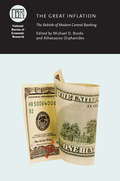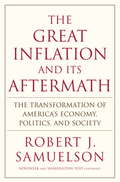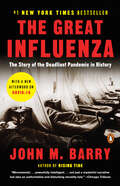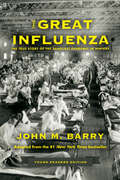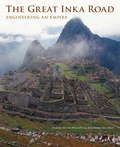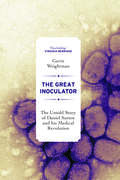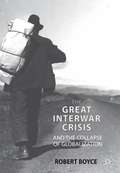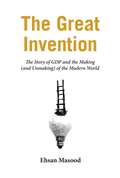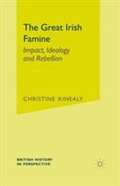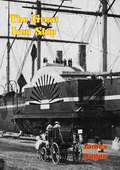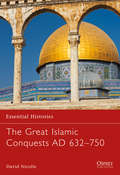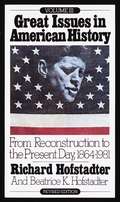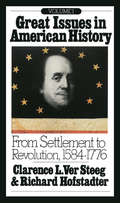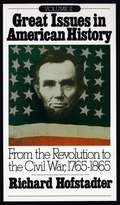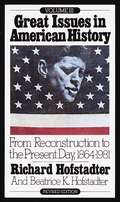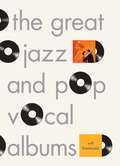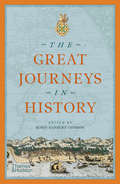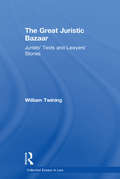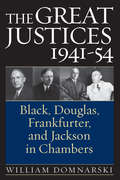- Table View
- List View
The Great Image Has No Form, or On the Non-object Through Painting
by Jane Marie Todd François JullienIn pre-modern China, elite painters used imagery not to mirror the world around them, but to evoke unfathomable experience. Considering their art alongside the philosophical traditions that inform it, The Great Image Has No Form explores the "non-object"- a notion exemplified by paintings that do not seek to represent observable surroundings. François Jullien argues that this non-objectifying approach stems from the painters' deeply held belief in a continuum of existence, in which art is not distinct from reality. Contrasting this perspective with the Western notion of art as separate from the world it represents, Jullien investigates the theoretical conditions that allow us to apprehend, isolate, and abstract objects. His comparative method lays bare the assumptions of Chinese and European thought, revitalizing the questions of what painting is, where it comes from, and what it does. Provocative and intellectually vigorous, this sweeping inquiry introduces new ways of thinking about the relationship of art to the ideas in which it is rooted.
The Great Impersonation (British Library Spy Classics #0)
by Edward Phillips OppenheimEast Africa, 1913. The disgraced English aristocrat Everard Dominey stumbles out of the bush, and comes face to face with his lookalike – the German Baron von Ragastein. Months later, Dominey returns to London and resumes his glittering social life. But is it really Dominey who has come back– or a German secret agent seeking to infiltrate English high society? As international tension mounts and the great powers of Europe move closer to war, Dominey finds himself entangled in a story of suspicion and intrigue. He must try to evade his insane and murderous wife as well as escape the attentions of the passionate Princess Eiderstrom – and will eventually uncover the secret of the ghost that haunts his ancestral home. This classic thriller was hugely popular when it was first published in 1920, selling over one million copies in that year alone, and was filmed three times. It was selected by the Guardian as one of 1000 novels everyone must read.
The Great Impostor
by Robert CrichtonThe fantastic lives and careers of Ferdinand Waldo Demara make a fantastic irony of the platitude that truth is stranger than fiction. For with Ferdinand Demara, truth is fiction.Demara wanted to be a hero, to lead an epic life dedicated to the benefit of others, and to gain adulation for himself, and he did all those things by lying to others about who he was. During his storied career, Ferdinand Demara managed to "become" a Trappist monk; a doctor of psychology and Dean of the School of Philosophy at a small college in Pennsylvania; a law student, zoology graduate, cancer researcher and teacher at a junior college in Maine; a surgeon-lieutenant in the Royal Canadian Navy (as medical officer on the destroyed Cayuga, he successfully performed major surgery); a brilliant assistant warden of a Texas prison; and a teacher and beloved idol of the children on a Maine island village.In this forthright account of a remarkable fraud, Robert Crichton presents the man, his reasons, and his methods. A New York Times bestseller when it was originally published in 1959, and serving as the inspiration for the Tony Curtis film of the same name, this is the fascinating and disturbing story of America's Great Impostor.
A Great Improvisation: Franklin, France, and the Birth of America
by Stacy SchiffStacy Schiff draws from new and little-known sources to illuminate the least-explored part of Franklin's life. From these pages emerge a particularly human and yet fiercely determined Founding Father, as well as a profound sense of how fragile, improvisational, and international was our country's bid for independence.
A Great Improvisation: Franklin, France, and the Birth of America
by Stacy SchiffSoon to be a streaming series ● In this dazzling work of history, a Pulitzer Prize-winning author follows Benjamin Franklin to France for the crowning achievement of his careerIn December of 1776 a small boat delivered an old man to France." So begins an enthralling narrative account of how Benjamin Franklin--seventy years old, without any diplomatic training, and possessed of the most rudimentary French--convinced France, an absolute monarchy, to underwrite America's experiment in democracy. When Franklin stepped onto French soil, he well understood he was embarking on the greatest gamble of his career. By virtue of fame, charisma, and ingenuity, Franklin outmaneuvered British spies, French informers, and hostile colleagues; engineered the Franco-American alliance of 1778; and helped to negotiate the peace of 1783. The eight-year French mission stands not only as Franklin's most vital service to his country but as the most revealing of the man.In A Great Improvisation, Stacy Schiff draws from new and little-known sources to illuminate the least-explored part of Franklin's life. Here is an unfamiliar, unforgettable chapter of the Revolution, a rousing tale of American infighting, and the treacherous backroom dealings at Versailles that would propel George Washington from near decimation at Valley Forge to victory at Yorktown. From these pages emerge a particularly human and yet fiercely determined Founding Father, as well as a profound sense of how fragile, improvisational, and international was our country's bid for independence.
Great Inaugural Addresses: From Washington To Reagan (Dover Thrift Editions)
by James DaleyThe President's inaugural address reflects the current state of the nation and offers insights into the coming administration. This collection features the voices of twenty Chief Executives, from George Washington's 1789 oration to the 2009 speech by Barack Obama. Highlights include John F. Kennedy's exhortation to "Ask not what your country can do for you," Franklin D. Roosevelt's assertion that "the only thing we have to fear is fear itself," and Abraham Lincoln's wartime vision of "a just and lasting peace among ourselves and with all nations."An ideal resource for students of political science and American history, this compendium of stirring speeches will inspire readers of every political persuasion.
The Great Inflation: The Rebirth of Modern Central Banking
by Michael D. Bordo Athanasios OrphanidesControlling inflation is among the most important objectives of economic policy. By maintaining price stability, policy makers are able to reduce uncertainty, improve price-monitoring mechanisms, and facilitate more efficient planning and allocation of resources, thereby raising productivity. This volume focuses on understanding the causes of the Great Inflation of the 1970s and OCO80s, which saw rising inflation in many nations, and which propelled interest rates across the developing world into the double digits. In the decades since, the immediate cause of the periodOCOs rise in inflation has been the subject of considerable debate. Among the areas of contention are the role of monetary policy in driving inflation and the implications this had both for policy design and for evaluating the performance of those who set the policy. Here, contributors map monetary policy from the 1960s to the present, shedding light on the ways in which the lessons of the Great Inflation were absorbed and applied to todayOCOs global and increasingly complex economic environment.
The Great Inflation and its Aftermath: The Past and Future of American Affluence
by Robert J. SamuelsonIt's a giant gap in our history. The Great Inflation, argues award-winning columnist Robert J. Samuelson in this provocative book, was the worst domestic policy blunder of the postwar era and played a crucial role in transforming American politics, economy, and everyday life--and yet its story is hardly remembered or appreciated. In these uncertain economic times, it is more imperative than ever that we understand what happened in the 1960s and 1970s, lest we be doomed to repeat our mistakes. From 1960 to 1979, inflation rose from barely more than 1 percent to nearly 14 percent. It was the greatest peacetime inflationary spike in this nation's history, and it had massive repercussions in every area of our lives. The direct consequences included Ronald Reagan's election to the presidency in 1980, stagnation in living standards, and a growing belief-both in America and abroad--that the great-power status of the United States was ending. The Great Inflation and Its Aftermath traces the origins and rise of double-digit inflation and its fall in the brutal 1981-82 recession, engineered by the Federal Reserve under then-chairman Paul Volcker and with the staunch backing of Reagan. But that is only half the story. The end of high inflation triggered economic and social changes that are still with us. The stock market and housing booms were both direct outcomes; American business became more productive--and also much less protective of workers; and globalization was encouraged. We cannot understand today's world, Samuelson contends, without understanding the Great Inflation and its aftermath. Nor can we prepare for the future unless we heed its lessons. This incisive and enlightening book will stand as the authoritative account of a watershed event of our times.
The Great Influenza: The Story of the Deadliest Pandemic in History
by John BarryAt the height of WWI, history's most lethal influenza virus erupted in an army camp in Kansas, moved east with American troops, then exploded, killing as many as 100 million people worldwide. <P><P>It killed more people in twenty-four months than AIDS killed in twenty-four years, more in a year than the Black Death killed in a century. But this was not the Middle Ages, and 1918 marked the first collision of science and epidemic disease. <P><P>Magisterial in its breadth of perspective and depth of research and now revised to reflect the growing danger of the avian flu, The Great Influenza is ultimately a tale of triumph amid tragedy, which provides us with a precise and sobering model as we confront the epidemics looming on our own horizon. <P><P>John M. Barry has written a new afterword for this edition that brings us up to speed on the terrible threat of the avian flu and suggest ways in which we might head off another flu pandemic. <P><P><b>A New York Times Bestseller</b>
The Great Influenza: The True Story of the Deadliest Pandemic in History (Young Readers Edition)
by John M. BarryThe strongest weapon against pandemic is the truth. Read why in the definitive account of the 1918 Influenza Epidemic, adapted for young readers from the #1 New York Times bestseller.At the height of World War I, history&’s most lethal influenza virus erupted in an army camp in Kansas, moved east with American troops, and then exploded worldwide, killing as many as 100 million people. It killed more in twenty-four months than AIDS killed in twenty-four years, more in a year than the Black Death killed in a century. It killed many more people than COVID-19, especially those who were young and otherwise healthy.This book, adapted from the #1 New York Times bestseller first published in 2004, shows young readers how this global tragedy came to pass; how science, war, and public policy collided; and how we might be able to prevent it from happening again. Impeccably researched and engrossingly told, The Great Influenza provides young readers with historical and scientific context for epidemics that remains all too relevant today.
The Great Inka Road
by David Penney Ramiro Matos Jose Barreiro John OschendorfThis compelling collection of essays explores the Qhapaq nan (or Great Inca Road), an extensive network of trails reaching modern-day Colombia, Ecuador, Peru, Bolivia, Chile, and Argentina. These roads and the accompanying agricultural terraces and structures that have survived for more than six centuries are a testament to the advanced engineering and construction skills of the Inca people. The Qhapaq nan also spurred an important process of ecological and community integration across the Andean region. This book, the companion volume to a National Museum of the American Indian exhibition of the same name, features essays on six main themes: the ancestors of the Inca, Cusco as the center of the empire, road engineering, road transportation and integration, the road in the Colonial era, and the road today. Beautifully designed and featuring more than 225 full-color illustrations, The Great Inka Road is a fascinating look at this enduring symbol of the Andean peoples' strength and adaptability.
The Great Inoculator: The Untold Story of Daniel Sutton and his Medical Revolution
by Gavin WeightmanSmallpox was the scourge of the eighteenth century: it showed no mercy, almost wiping out whole societies. Young and old, poor and royalty were equally at risk – unless they had survived a previous attack. Daniel Sutton, a young surgeon from Suffolk, used this knowledge to pioneer a simple and effective inoculation method to counter the disease. His technique paved the way for Edward Jenner&’s discovery of vaccination – but, while Jenner is revered, Sutton has been vilified for not widely revealing his methods until later in life. Gavin Weightman reclaims Sutton&’s importance, showing how the clinician&’s practical and observational discoveries advanced understanding of the nature of disease. Weightman explores Sutton&’s personal and professional development, and the wider world of eighteenth-century health in which he practised inoculation. Sutton&’s brilliant and exacting mind had a significant impact on medicine – the effects of which can still be seen today.
The Great Interwar Crisis and the Collapse of Globalization
by Robert BoyceChallenging the standard narrative of Interwar International History, this account establishes the causal relationship between the global political and economic crises of the period, and offers a radically new look at the role of ideology, racism and the leading liberal powers in the events between the First and Second World Wars.
The Great Invention: The Story of GDP and the Making and Unmaking of the Modern World
by Ehsan MasoodThe fascinating story of one of the twentieth-century's most influential and dangerously addictive ideas, told through the lives of those who invented it. The world's principal measure of the health of economies is gross domestic product, or GDP: the sum of what all of us spend every day, from the contents of our weekly shopping to large capital spending by businesses. GDP also includes the myriad things that our governments pay for, from libraries and road-line painting to naval dockyards and nuclear weapons. The Great Invention reveals how in just a few decades GDP became the world's most powerful formula: how six algebraic symbols forged in the fires of the 1930's economic crisis helped Europe and America prosper, how the remedy now risks killing the patient it once saved, and how this fundamentally flawed metric is creating the illusion of global prosperity--and why many world leaders want to be able to ignore it but so far remain powerless to do so. Drawing on interviews, firsthand accounts, and previously neglected source materials, The Great Invention takes readers on a journey from Capitol Hill to Whitehall--on the trail of theories made in Cambridge, tested in Karachi, and designed for global application--into the minds of unworldly geniuses seduced by the allure of power and the demands of politics.
The Great Irish Famine
by Christine KinealyThe Great Irish Famine of 1845-51 was both one of the most lethal famines in modern history and a watershed in the development of modern Ireland. This book - based on a wide range of little-used sources - demonstrates how the Famine profoundly affected many aspects of Irish life: the relationship between the churches; the nationalist movement; and the relationship with the monarchy. In addition to looking at the role of the government, Kinealy shows the importance of private charity in saving lives. One of the most challenging aspects of the publication is the chapter on food supply, in which Kinealy concludes that, despite the potato blight, Ireland was still producing enough food to feed its people. The long-term impact of the tragedy, notably the way in which it has been remembered and commemorated, is also examined.
The Great Iron Ship
by James DuganIF EVER there was a subject fit for the hand of the biographer, the story of the Great Eastern is surely it. James Dugan has made the entertaining most of a monstrous but true episode of the high Victorian days, the age of iron and the mechanical engineer. He has written a failure-story far more amusing than most success-stories could be: and out of 692 feet and 12.000 tons of iron he has made a character almost human in its foibles and its superb talent for getting into trouble.Before the Great Eastern had made her first trip to New York, she had eaten up $5,000,000, the first of the fortunes she regularly swallowed on every voyage. She had hardly steamed a few dozen miles when the forward funnel blew out. She passed through the hands of three groups of shareholders before she ever carried a paying passenger. Everything that could possibly happen to a ship happened to the Great Eastern. Tanks of fish oil deluged her engine deck. Two horses died of a bad cold because she passed too close to an iceberg. On her fourth voyage she got stuck in Flushing Bay, at the western end of Long Island Sound, with a gash in her bottom that would have comfortably accommodated an ordinary-sized ship. Storm, mechanical failure, inefficient captains and crew—the Great Eastern had everything. She almost cut New York in two when she first docked.Into her story enter such figures as Cyrus Field—who made use of the Great Eastern to lay the Atlantic cable; Louis Napoleon—he wrested the leviathan just in time from the hands of the Sultan of Turkey, who wanted to use her to house his harem; Jules Verne, Du Chaillu. Indian nabobs, the war correspondent Scott Russell, and dozens of other figures of a bygone age.The whole story is told by Mr. Dugan with an unfailing appreciation of the high, low and medium comedy involved in the Great Eastern’s crazy career, and with a sharp eye for the Victorian background and personalities.
The Great Islamic Conquests AD 632-750
by David NicolleFew, if any, centuries in world history have had such a profound and long-lasting impact as the first hundred years of Islamic history. In this book, David Nicolle, a former member of the BBC's Arabic service, examines the extensive Islamic conquests between 632 and 750 AD. These years saw the religion and culture of Islam, as well as the Arabic language, erupt from the Arabian Peninsula to spread across an area far larger than that of the Roman Empire at its greatest extent. It also saw the abrupt collapse of the Persian Empire, as well as the permanent withdrawal of the Romano-Byzantine Empire and its associated cultures, along with Christianity as a ruling faith, from the Middle East and North Africa. Virtually all the lands "opened" by their armies remain Islamic - and in many cases Arabic-speaking - to this day, in contrast to the often ephemeral achievements of better-known conquerors, such as Alexander the Great and several Roman Caesars, and the effects of this rapid expansion was to shape European affairs for centuries to come.
Great Issues in American History: From Reconstruction to the Present Day, 1864-1981
by Richard Hofstadter Beatrice K. HofstadterThe third volume in Great Issues In American History, From Reconstruction to the Present Day is now updated and revised to include another decade of American history. Beatrice K. Hofstadter, wife of the late Richard Hofstadter and herself an historian who worked with him closely on the original edition, has added a new section covering 1970 to 1981 and rearranged other sections in the light of what has since proved to be of lasting importance. This collection of significant documents in American history now goes from Lincoln's Proclamation on the Wade-Davis Bill on July 8, 1864, to Reagan's Address on Arms Control Negotiations on November 18, 1981.
Great Issues in American History, Vol. I: From Settlement to Revolution, 1584-1776 (Great Issues in American History #1)
by Richard Hofstadter Clarence L. Ver SteegThis first volume of Great Issues in American History -- three volumes of documents that cover the history of America from its settlement to the present -- gives us a generous sampling from the major political controversies in the Colonial period. Included are such documents as Richard Hakluyt's "Discourse of Western Planting" (1584), "Letter from Christopher Columbus to the King and Queen of Spain" (undated, probably 1694), "The Third Virginia Charter" (1612), Thomas Paine's "Common Sense" (1776) and "The Declaration of independence" (July 4, 1776). Each has an explanatory headnote, and there are brief general introductions that set the selections in their historical context.In order to fit both Colonial and Early National courses, documents covering 1765-1776 appear at the end of this volume and again at the beginning of Volume II.Volume II From the Revolution to the Civil War, 1765-1865 Edited by Richard HofstadterVolume III From Reconstruction to the Present Day, 1864-1981Edited by Richard Hofstadter and Beatrice K. HofstadterFrom the Trade Paperback edition.
Great Issues in American History, Vol. II: From the Revolution to the Civil War, 1765-1865 (Great Issues in American History #2)
by Richard HofstadterFrom the Revolution to the Civil War, 1765-1865
Great Issues in American History, Vol. III: From Reconstruction to the Present Day, 1864-1981 (Great Issues in American History #3)
by Richard HofstadterThe third volume in Great Issues In American History, From Reconstruction to the Present Day is now updated and revised to include another decade of American history. Beatrice K. Hofstadter, wife of the late Richard Hofstadter and herself an historian who worked with him closely on the original edition, has added a new section covering 1970 to 1981 and rearranged other sections in the light of what has since proved to be of lasting importance. This collection of significant documents in American history now goes from Lincoln's Proclamation on the Wade-Davis Bill on July 8, 1864, to Reagan's Address on Arms Control Negotiations on November 18, 1981.Volume IFrom Settlement to Revolution. 1584-1776 Edited by Clarence L. Ver Steeg and Richard HofstadterVolume IlFrom the Revolution to the Civil War. 1765-1865Edited by Richard HofstadterFrom the Trade Paperback edition.
The Great Jazz and Pop Vocal Albums
by Will FriedwaldThe author of the magisterial A Biographical Guide to the Great Jazz and Pop Singers now approaches the great singers and their greatest work in an innovative and revelatory way: through considering their finest albums, which is the format in which this music was most resonantly organized and presented to its public from the 1940s until the very recent decline of the CD. It is through their albums that Ella Fitzgerald, Frank Sinatra, Peggy Lee, Sarah Vaughan, Nat King Cole, Judy Garland, and the rest of the glorious honor roll of jazz and pop singers have been most tellingly and lastingly appreciated, and the history of the album itself, as Will Friedwald sketches it, can now be seen as a crucial part of musical history. We come to understand that, at their finest, albums have not been mere collections of individual songs strung together arbitrarily but organic phenomena in their own right. A Sinatra album, a Fitzgerald album, was planned and structured to show these artists at their best, at a specific moment in their artistic careers. Yet the albums Friedwald has chosen to anatomize go about their work in a variety of ways. There are studio and solo albums: Lee’s Black Coffee, June Christy’s Something Cool, Cassandra Wilson’s Belly of the Sun. There are brilliant collaborations: famous ones—Tony Bennett and Bill Evans, Louis Armstrong and Oscar Peterson—and wonderful surprises like Doris Day and Robert Goulet singing Annie Get Your Gun. There are theme albums—Dinah Washington singing Fats Waller, Maxine Sullivan singing Andy Razaf, Margaret Whiting singing Jerome Kern, Barb Jungr singing Bob Dylan, and the sublime Jo Stafford singing American and Scottish folk songs. There are also stunning concert albums like Ella in Berlin, Sarah in Japan, Lena at the Waldorf, and, of course, Judy at Carnegie Hall. All the greats are on hand, from Kay Starr and Carmen McRae to Jimmy Scott and Della Reese (Della Della Cha Cha Cha). And, from out of left field, the astounding God Bless Tiny Tim. Each of the fifty-seven albums discussed here captures the artist at a high point, if not at the expected moment, of her or his career. The individual cuts are evaluated, the sequencing explicated, the songs and songwriters heralded; anecdotes abound of how songs were born and how artists and producers collaborated. And in appraising each album, Friedwald balances his own opinions with those of musicians, listeners, and critics. A monumental achievement, The Great Jazz and Pop Vocal Albums is an essential book for lovers of American jazz and popular music.
The Great Journeys in History
by Robin Hanbury-TenisonThe adventurous stories of the greatest explorers in history, illustrated with hundreds of evocative portraits, photographs, paintings, and maps. Marco Polo, Ferdinand Magellan, David Livingstone, Amelia Earhart, Neil Armstrong: these are some of the greatest travelers of all time. This book chronicles their stories and many more, describing epic voyages of discovery and exploration, from the extraordinary migrations out of Africa by our earliest ancestors to the latest voyages into space. In antiquity, we follow Alexander the Great to the Indus and Hannibal across the Alps; in medieval times we trek beside Genghis Khan and Ibn Battuta. The Renaissance brought Columbus to the Americas and the circumnavigation of the world. The following centuries saw gaps in the global maps filled by Tasman, Bering, and Cook, and journeys made for scientific purposes, most famously by von Humboldt and Darwin. In modern times, the last inhospitable ends of the earth were reached including both poles and the world's highest mountain and new elements were conquered. Here are human stories of great triumph and success, but also of terrible hardships, tragedy, and astonishing courage in adversity. An incredible team of contributors from distinguished historians and writers to travelers and explorers bring firsthand experience to the journeys and places they describe. The contributors include Robert Ballard, Barry Cunliffe, Ranulph Fiennes, Pen Hadow, John Hemming, Robin Knox-Johnston, Christopher Ondaatje, and Simon Winchester.
The Great Juristic Bazaar: Jurists' Texts and Lawyers' Stories (Collected Essays In Law Ser.)
by William TwiningSome law students find jurisprudence daunting, impersonal, dry and seemingly detached from practical affairs. William Twining believes that many jurists have been fascinating people struggling with questions that are both historically significant and relevant to contemporary issues. This book brings together previously published essays that centre on three related themes: reading Juristic texts, the role of narrative in law, and relations between theory and practice. Building on a pragmatic view of jurisprudence, the author explores different ways of reading and using Juristic texts, to set them in context, to bring them to life and to engage with the reader's own concerns. He applies this approach to throw fresh light on four familiar figures - Holmes, Bentham, Hart and Llewellyn. Challenging limited agendas and parochial points of view, Twining outlines a programme for a broad approach to legal theory in the context of globalization. He satirizes some bad habits in jurisprudence and explores in depth how stories can be seductive vehicles for cheating in legal contexts, yet are essential for making sense of disputes about fact or law.
The Great Justices 1941-54
by William DomnarskiDomnarski is a practicing intellectual property attorney in California and the author of a previous book on the history and nature of federal court judicial opinions. In this text, the author compares four brilliant and diverse jurists of the Roosevelt-era Court--Hugo Black, William O. Douglas, Felix Frankfurter, and Robert Jackson--during the period from 1941 to 1954. The study explores the Court's evolving civil rights jurisprudence that was born in the period during which the four justices served together, considers the Court as an institution and its relation to the American public, and analyzes how four individual justices sharing core jurisprudential beliefs and ambitions before appointment would later divide into competing liberal and conservative factions. Annotation ©2006 Book News, Inc. , Portland, OR (booknews. com)
